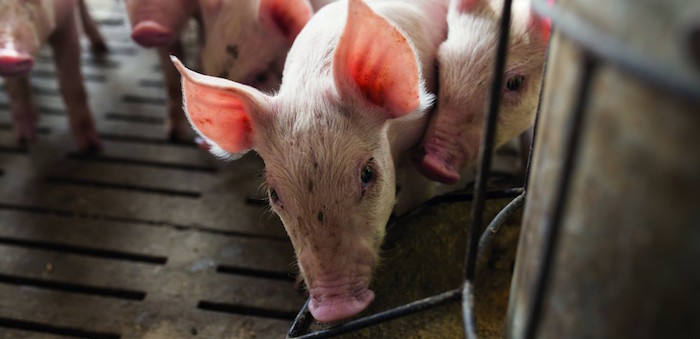As the animal feed and farming industries pursue sustainable alternatives to soya, the EU is considering the reintroduction of processed animal proteins (PAP) in livestock feed. Chloe Ryan reports on whether and, if so, when it might happen
The EU is considering lifting the ban on inter-species feeding, potentially paving the way for the reintroduction of processed animal proteins (PAP) to livestock feed.
For the pig sector, this could mean producers will be able to buy feed that includes poultry protein. It could also result in a new market for pigmeat in the form of poultry feed.
PAP was banned in ruminant diets in the EU in 1994 as a result of the BSE crisis. The UK introduced its own mammalian meat and bone meal (MBM) ban in April 1996 in the immediate aftermath of the announcement in the House of Commons, linking infected cattle with human disease vCJD. In 2001, the EU law was expanded to ban feeding of all PAP to all farm animals, with limited exceptions.
Now, with BSE widely considered to be a thing of the past, that could be about to change – although it would be unwise to expect any major breakthroughs soon.
Defra told Pig World that it had not yet seen any draft legislation from the EU, but its understanding was that the EU was ‘considering the lifting of the ban on inter- species feeding of non-ruminant feed – that is the feeding of insect PAP to pigs and poultry and of pig PAP to poultry and poultry PAP to pigs’.
A Defra spokesperson said the UK Government supported ‘making appropriate revisions to legislation in a proportionate and precautionary way in response to changing scientific assessment of risk’.
Brexit, as ever, potentially clouds the picture, but the spokesperson stressed that leaving the EU did not necessarily mean the UK industry would diverge from EU rules should it lift the ban at some point in the future. “We will look at any such proposals carefully when considering whether it is appropriate to also change UK legislation following EU exit,” the spokesperson said.
For the animal feed and farming industries, the move would potentially ease some of the pressure to use sustainable protein, given the current focus on soya. That would have to be weighed against any disease risk and possible concerns within the supply chain and amongst the public.
Nick Major, corporate affairs director at ForFarmers, said a change in the law would be welcome. “Finding alternative sources
of sustainable protein is a key priority for ForFarmers and as such we support this potential reauthorisation of non-ruminant PAP – it offers a valuable and sustainable source of high quality protein,” he said.
He anticipates that the European Commission will reauthorise the use of PAP as a feed material ‘once a robust process has been put in place to remove the risk of any potential cross-contamination in feed mills, as part of the manufacturing process’.
This is a key point. The risk of cross- contamination in feed mills is, at the moment, a major sticking point, because it is uncertain whether the technology exists to provide the necessary assurances.
Mr Major stressed that ForFarmers’ support of reintroduction was ‘on the basis of any legislation around its use in feed mills being practical and workable and, of course, that our farmer customers and our end consumers are willing to accept its use as a feed material’.
ROBUST PROCESS
The European farming union Copa Cogeca has contacted the European Commission for more details and was told the EU Reference Laboratory is still having problems developing molecular tests capable of separating the different PAPs species, which was likely to delay the authorisation.
The problem has always been identifying different PAP species in a sample, which is essential to ensure that pig PAPs are not fed to pigs and poultry PAPs are not fed to poultry, according to the NFU’s senior European policy adviser Katie Jarvis.
This may be more straightforward for pig PAP in poultry feed than vice versa because poultry-only feed mills are commonplace in the UK, but there are no pig-only feed mills, according to NPA chief executive Zoe Davies, who said the reintroduction of PAP would, on the whole, be a welcome move.
“There are lots of potential benefits. It is a good protein source with the right amino acid balance. It poses a low risk for health and disease as long as cross contamination is managed properly. It also provides an excellent alternative to soya – so reducing our environmental impact,” she said.
There are potential disadvantages, too. PAP is already used as a protein source so there will be competition with other sectors such as fish farming and pet food, and it might be expensive. “All protein sources tend to find their own level in the market so it would not be the silver bullet some may expect, price-wise,” she added.
PACE OF CHANGE
Despite the change of tone from the EU on inter-species feeding, it seems clear that the pace of change is likely to be slow. Ms Jarvis said that for the three years she has been based in Brussels – and for quite a while before that – the Commission has been talking about reintroducing pig and poultry PAPs into feed.
“But there’s still no clear indication of when this could be made possible,” she said. “If it were, it would be approved at EU level and then it would be up to individual member states to enable it.
“The UK is in an interesting position in this regard, because, as it is a food safety issue, I don’t know whether the UK would follow European food safety advice or carry out its own tests,” she said.
Dr Davies said the NPA has experienced a lot of government resistance to allowing this in the past, particularly from the Department of Health. “Education is key and barriers would need to be lifted before we could take advantage of PAP,” she said.
And if the EU did change the rules, it would be hugely important for British pig producers that the post-Brexit UK followed suit. “The last thing we need is for the EU to allow it and not the UK as we would be severely disadvantaged on cost and reputation, as they would have a rainforest- destroying soya-free diet,” she said.
There are other issues to consider, too. How will retailers and their customers see the reintroduction of PAP? And how will retailers decide they want to play it, in terms of product labelling?
This reintroduction, if and when it does happen, will be a big deal. “The big question is whether retailers, or more importantly consumers, will accept it,” said Charles Bourns, a poultry farmer and chair of the poultry group at Copa Cogeca. “That’s the acid test. I think producers will welcome it. And it’ll also improve productivity and margin, in my opinion.”
However, Mr Bourns predicted there would be ‘a big hoo-ha’ if it happened: “I think about 95% of consumers will accept it. But the remaining 5% will be extremely loud in their protests. It’ll be a similar situation to when people objected to GM soya. But when non-GM soya was in short supply, it soon quietened down.”
Dr Davies added: “I’m not sure if retailers would accept it, but, again, it will depend on how it is promoted and how much pressure they get to reduce soya use for animal feed. We’ve long promoted the pig as a vegetarian – but I’m not sure this message has really resonated with the public in any case.”
ALTERNATIVE SOURCE
While these conversations are happening, there are parallel discussions about another alternative source to replace ‘expensive’ and less digestible soya protein – insect protein. It’s possible this may gain approval before PAP – it would certainly be considered less controversial.
Either way, momentum is building for a change. Defra, the EU, farming organisations and feed companies are all on board. But there are more barriers to overcome before the law changes and livestock farmers gain access to a valuable source of protein that reduces the industry’s reliance on soya and provides an additional route to market for pig and poultry products.




